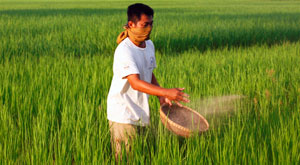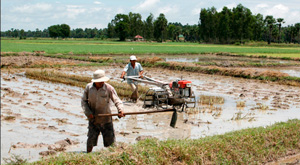Australia is working with agricultural businesses and local governments in Cambodia to help up to 230,000 of the country's poorest farmers grow more rice, fruit and vegetables.
About 10 million Cambodians depend on growing small rice, fruit and vegetable crops for a large part of their incomes.
Typical small farmers may grow a single, one hectare, rain-fed rice crop of 2 to 2.5 tonnes a year, of which 1.5 tonnes is consumed by their family and the surplus sold. At a price of around $250 per tonne, farmers need to increase their productivity to have enough rice to sell to lift their families out of poverty.
The Cambodia Agricultural Value Chain (CAVAC) program helps farmers in three provinces learn how to improve their crops, build irrigation systems and access the better quality agricultural products and markets they need.
To help them increase productivity, the program partners with businesses and government to improve the quality of advice, products and support farmers receive through agricultural markets.
It is AusAID's first major program using the making markets work for the poor (external website) approach, which is based on the understanding that markets play a central role in the lives of the poor. By 2016, it is estimated that CAVAC will have enabled poor farmers to generate an extra $40 million of additional net income each year.
Low-cost irrigation schemes
Irrigation enables farmers to grow additional crops of high yielding rice in the dry season. Since 2010, CAVAC has helped build or bring close to completion nine irrigation schemes in Kampot, Kompong Thom and Takeo provinces. Farmers invest in the canals and the schemes are managed locally, involving provincial governments, water groups and private water sellers, to help ensure they are maintained. By 2016, CAVAC's investment is expected to irrigate an additional 32,000 hectares of land and enable about 21,000 households to grow at least one extra rice crop each year.
Better seeds, fertilisers, pesticides and information sharing
Using new seed varieties, good quality fertilisers and pesticides and new farming techniques can increase yields and save crops from destruction by pests. Distance and poor roads and communication limit farmers' access to products and increase their reliance on fertiliser, seed and equipment retailers and other farmers for advice.
CAVAC is helping retailers see the commercial benefit of stocking and promoting better quality products and advising farmers on their use. It has trained about 200 retailers and larger seed sellers, and many of them are investing in their retail networks to provide advice, as well as appropriate products.
CAVAC has brought together players in the agriculture sector including provincial government departments, the private sector, civil society organisations and farmers. Events held in three provinces, such as field demonstrations of products and equipment, promote better information sharing and encourage retailers and companies to provide high-quality information to farmers as a successful marketing strategy.
Model farmers
CAVAC is encouraging and training progressive and entrepreneurial farmers to promote change in their villages. CAVAC will train 20,000 to be model farming households in new agricultural technologies, and forecasts that around 12,000 of them will directly share their knowledge with 120,000 other farming households. Three quarters of the model farmers trained have already reported an increase in their own yields and have seen changes in their neighbours' farming practices.
CAVAC activities also include agricultural research, providing agricultural advice through a call centre and media organisations producing dramas including a TV program based on smallholder agriculture.
The $48 million program is running from 2009 to 2014.


